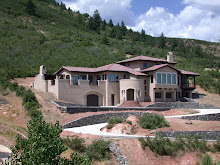
FLAT ROOFS: This is probably the most expensive roof system. A flat roof is not actually flat, it slopes slightly to drain, about 1/4" per foot. The slope is created by roof trusses or tapered roof insulation boards. The roof drains through scuppers and downspouts. Most flat roofs today use some version of an EPDM rubber roof membrane. This membrane can be glued down or have a round river rock ballast. Along with a high initial expense, flat roofs are more prone to problems and maintenance than other types of roof. Flat roofs are often seen in southwestern and contemporary designs.

METAL ROOFS: Metal roofs are the second most expensive roofs. They are usually steel, but come in a variety of types; corrugated, standing seam and panels, and also in a variety of colors as well as unfinished rusting steel roofs. A metal roof can be used on very low pitched roofs. They are often used in heavy snow areas because snow tends to slide off. They are fireproof. They can drain though gutters and downspouts.
TILE ROOFS: Most tile roofs use a concrete tile, better able to withstand freezing than the old clay tiles. They come in a variety of shapes and styles; barrel vault, shake, bar, and slate. Each profile comes in a variety of colors and a roof can be made of a blend of colors for a true custom look. Tile roofs are less expensive than metal, they are fireproof, and considered a lifetime roof. Any style of home can find a tile roof to compliment the design. They drain through gutters and downspouts.

]

FIBERGLASS ASPHALT SHINGLES: Fiberglass asphalt shingles can be a Class A roof, fire resistant. They are far less expensive than any of the previous roof choices. Fiberglass asphalt shingles come in a wide variety of styles, shapes, profiles and colors. Drainage is through gutters and downspouts. This is the most widely used roofing material on custom homes.
ROOFING PAPER: All sloped roof materials go over some form of roofing paper. It can be nailed down or self-adhesive. It protects the wood roof deck from moisture.
ICE SHIELD: In cold climates. Ice Shield, a bituminous, water proof, self-sealing membrane is places at all eaves, valleys and trouble spots. It helps prevent ice dams and other snow and ice related problems. In heavy snow areas and at high elevations, the entire roof may be covered in Ice Shield.
COLD ROOFS: In very high elevations and heavy snow areas, a cold roof is often used to avoid problems due to cold and snow. The roof is framed with a roof structure and sheathing, then an air gap is framed, often flat 2x4's and a second layer of roof decking. This gap is vented. The final roof material goes over this double roof. This double, cold roof prevents snow and ice build up. New methods of spray on foam insulation against the underside of the roof can eliminate the need for a cold roof.
OTHER ROOFING MATERIALS: There are other roofing materials available to choose from. Wood shakes, slate and synthetic roofing materials are sometimes used. Wood shakes are seldom used anymore because of fire danger and their weakness in hail. Slate is very expensive. New, synthetic materials are an unknown when considering how long they will last.
